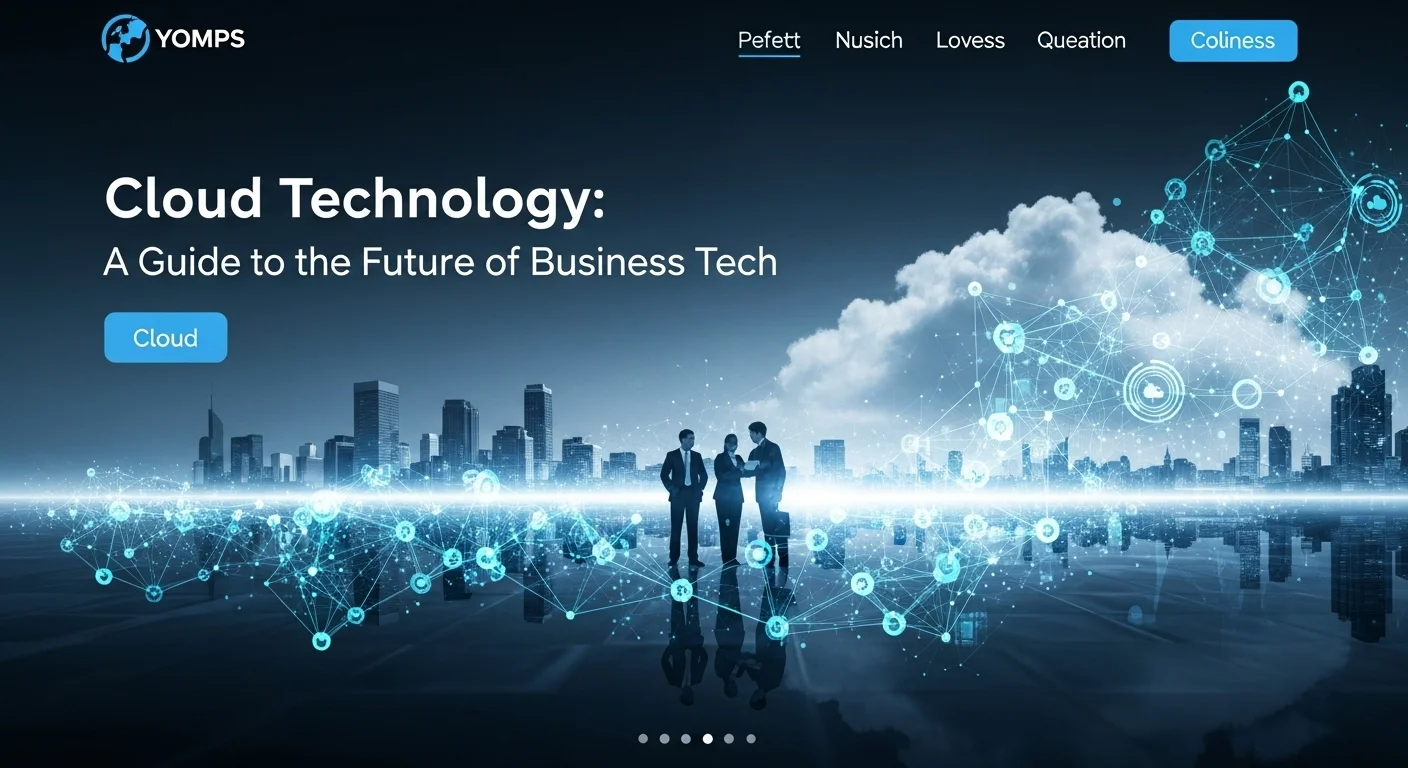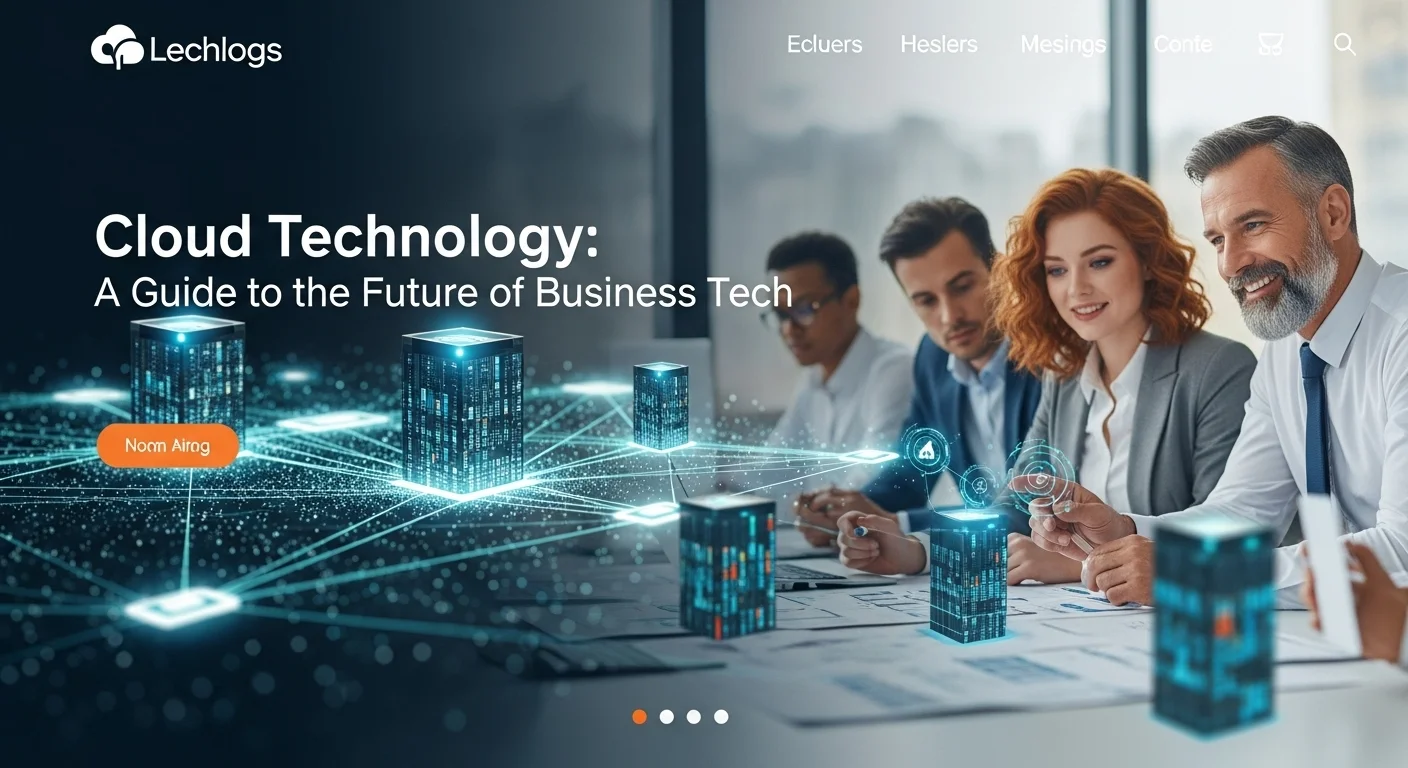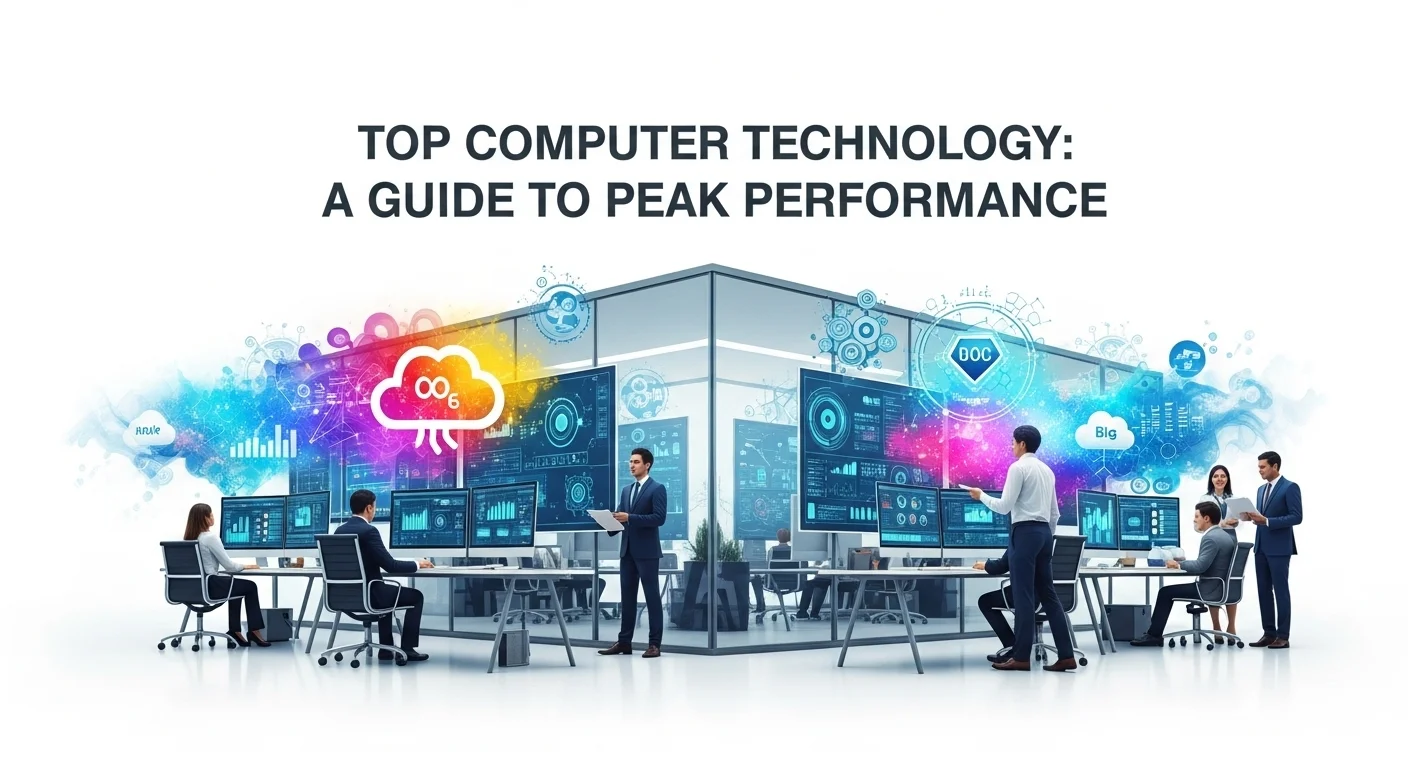What is Cloud Technology? A Plain-English Guide for Your Business

Executive Summary
I've spent years helping businesses navigate the shift to the cloud, and I've seen firsthand how it can be a game-changer. This article is my comprehensive guide to understanding cloud technology, stripped of the complex jargon. We'll cover what the cloud actually is, explore the different models like IaaS, PaaS, and SaaS, and discuss why 'cloud-native' is more than just a buzzword. I'll also break down the crucial role of a cloud engineer and look at real-world examples, like how Adobe Creative Cloud revolutionized creative workflows. Whether you're a business leader looking for a competitive edge or just curious about the tech that powers our digital world, this guide provides the clear, practical insights you need.
Table of Contents
What is the Cloud and Why Does it Matter?
In today's world, 'the cloud' is everywhere, but what does it actually mean? I remember the early days of my career, managing server rooms that were hot, noisy, and required constant maintenance. If we needed more power, it meant buying expensive new hardware and spending a weekend installing it. The cloud computing changed everything. Put simply, cloud computing means you're accessing resources—like storage, databases, and computing power—over the internet from a provider like Amazon Web Services (AWS), Microsoft Azure, or Google Cloud. Instead of owning and managing your own physical servers, you're essentially renting them on a flexible, pay-as-you-go basis. This shift has unlocked incredible levels of flexibility, scale, and efficiency for businesses of all sizes.
The importance of this is huge. The cloud is the silent engine behind services you use every day, from streaming your favorite show on Netflix to collaborating on a document with a colleague across the country. For businesses, it's a massive leveling of the playing field. It removes the enormous upfront cost of building your own IT infrastructure, turning a huge capital expense into a predictable operating cost. This means a small startup can access the same world-class technology as a massive corporation, fostering incredible innovation. The main benefits I've seen clients rave about are agility (scaling resources up or down in minutes), better collaboration with globally accessible data, and far more robust disaster recovery. By moving to the cloud, companies free up their tech teams to focus on building great products instead of just keeping the lights on.
Understanding the Core Service Models: IaaS, PaaS, and SaaS
To really get a handle on the cloud, you need to know the three main service models. I like to think of them using a building analogy:
- Infrastructure as a Service (IaaS): This is the most fundamental level. With IaaS, you're renting the raw building blocks: servers, storage, networking. It's like renting a plot of land and the raw materials. You have total control to build whatever you want, but you're also responsible for a lot of the construction and maintenance. This model offers the most flexibility and is for those who need deep control over their infrastructure.
- Platform as a Service (PaaS): PaaS gives you a ready-made environment to build, test, and deploy your software applications. The provider manages the underlying infrastructure for you. Think of this as renting a fully equipped workshop. You have all the tools and space you need to create your product (your application code) without worrying about maintaining the building or the power tools.
- Software as a Service (SaaS): This is the model most people are familiar with. SaaS delivers ready-to-use software over the internet, typically on a subscription basis. You don't manage the software or the infrastructure; you just use it. It's like renting a fully furnished and serviced apartment. A perfect example is the Adobe Creative Cloud. I remember when buying Photoshop meant getting a physical disc and a license key for one computer. Now, with the Creative Cloud subscription, professionals get access to the entire suite of updated tools on any device. This convenience is powered by the massive Adobe cloud infrastructure, which handles all the updates, storage, and access, perfectly illustrating the power of SaaS.
Deployment Models: Public, Private, and Hybrid
Finally, you have to decide where your cloud will live. There are three main ways to deploy:
- Public Cloud: This is when you use a third-party provider like AWS or Azure. You share the hardware with other customers (don't worry, your data is separate and secure). This model offers massive scale, no maintenance, and high reliability.
- Private Cloud: These are cloud resources used exclusively by one organization. It can be located at your own data center or hosted by a third party. This offers the most control and security, often required by industries with strict data regulations.
- Hybrid Cloud: This approach combines public and private clouds, allowing data and apps to be shared between them. It’s the 'best of both worlds' approach, giving businesses flexibility to keep sensitive data in a private cloud while leveraging the scale of the public cloud for less critical tasks.
Understanding these basics is the first step. The real magic happens when you start building applications specifically designed for this environment. This is the heart of cloud native architecture—a modern way of building apps that takes full advantage of what the cloud offers. And the experts who design and manage these complex systems are known as cloud engineers. These professionals are the architects of our digital future, handling everything from migrating old systems to deploying global applications. The seamless experience of a platform like the Adobe Creative Cloud is a direct result of the incredible work done by a team of skilled cloud engineers managing the vast, underlying platform.

A Practical Guide to Cloud Migration and Business Strategy
Moving to the cloud isn't just a technical task; it's a fundamental business decision that requires a solid strategy. When a client asks me where to begin, I tell them it's about more than just 'lifting and shifting' applications. It's about rethinking processes and embracing a cloud-first culture to unlock real agility and innovation.
Cloud Migration Strategies: The 7 Rs
Migrating to the cloud is a complex process, but it can be broken down. Over the years, the industry has settled on a framework known as the '7 Rs'. I use this as a checklist with my clients to decide the fate of each application.
- Rehost (Lift and Shift): This is the simplest approach. You move an application to the cloud with minimal changes. It's fast and often a good first step for companies that need to exit a data center quickly but aren't ready to rebuild everything.
- Replatform (Lift, Tinker, and Shift): Here, you make a few small optimizations to get some cloud benefits without a major overhaul. A common example is moving a database to a managed cloud service like Amazon RDS. You're not rebuilding the car, just upgrading the engine.
- Repurchase (Drop and Shop): This means ditching an old application and moving to a new, cloud-based one, usually a SaaS product. I've seen countless companies move from an on-premise CRM to Salesforce or from locally installed software to a service like the Adobe Creative Cloud. It offloads management and gives you a modern tool.
- Refactor / Re-architect: This is the most intensive strategy. You completely redesign your application to be cloud native. It's a big investment, but it's how you unlock maximum scalability, performance, and resilience. This is for your most critical, high-growth applications.
- Relocate: This is a more specialized strategy, mainly for moving virtual machines to the cloud quickly without rewriting them. It's like moving your entire server rack, virtually, to the cloud provider's data center.
- Retain: Sometimes, the smartest move is to do nothing. An application might be too critical and complex to move, or it might be approaching the end of its life anyway. You simply leave it where it is.
- Retire: It’s amazing how many applications are running that nobody uses. A migration project is a perfect opportunity to identify these and shut them down, saving money and reducing complexity.
The Rise of Cloud-Native Architecture
To truly get the most from the cloud, you should build new applications with a cloud native mindset. This isn't about a location; it's a philosophy. It means building apps that are designed for the dynamic, scalable nature of the cloud. Key concepts here include:
- Microservices: Instead of building one giant, monolithic application, you break it down into a collection of small, independent services. Each one handles a specific function. This makes the application easier to update, scale, and more resilient. If one service fails, it doesn't bring down the entire system.
- Containers: Tools like Docker package an application and all its dependencies into a neat little box called a container. This ensures the app runs the same way everywhere, from a developer's laptop to the production cloud environment. Kubernetes has become the standard for managing these containers at scale.
- DevOps and CI/CD: A cloud-native approach goes hand-in-hand with a DevOps culture, where development and operations teams work closely together. Automated pipelines (CI/CD) handle the building, testing, and deployment of code, allowing companies to release updates faster and more reliably.
The Critical Role of the Cloud Engineer
Making all of this happen requires a special kind of expert: the cloud engineer. This isn't just a new name for a system administrator. A cloud engineer is responsible for designing, planning, and managing these complex cloud environments. Their work is incredibly broad and often specialized:
- Cloud Architect: The visionary who designs the overall cloud strategy and structure.
- Cloud Developer: The builder who writes code for cloud-based applications, using cloud services to speed up development.
- Cloud Administrator (SysOps): The operator who keeps the cloud environment running smoothly, monitoring performance and security.
- Cloud Security Engineer: The guardian who protects the entire cloud infrastructure from threats.
A great cloud engineer is a problem-solver who understands not just the technology but also the business goals. The amazing functionality of the Adobe Creative Cloud—from real-time collaboration to instant file sync—is a testament to a massive team of cloud engineers. They ensure the underlying Adobe cloud platform is robust enough to serve millions of creatives worldwide. For anyone looking to build a career in tech, becoming a cloud engineer is one of the most exciting paths you can take, as it places you at the very heart of modern innovation.

Tips and Strategies to Master Your Cloud Experience
Getting your systems onto the cloud is just the beginning. To truly succeed, you need to continuously optimize your environment, stick to best practices, and keep an eye on what's next. This is where you turn your cloud investment into a real competitive advantage.
Best Practices for Cloud Security and Cost Management
From my experience, the two areas that can make or break a cloud strategy are security and cost. I've seen companies suffer from data breaches due to simple misconfigurations and others get shocked by a massive, unexpected bill. Here are some hard-won lessons.
Cloud Security Best Practices: Remember, security in the cloud is a shared responsibility. Your provider secures the cloud, but you are responsible for securing what's *in* the cloud.
- Adopt a Zero Trust Model: The guiding principle should be 'never trust, always verify.' Authenticate and authorize every single request for access, even if it comes from inside your network.
- Use Multi-Factor Authentication (MFA): This is non-negotiable. Enforce MFA on all accounts, especially administrative ones. It’s one of the most effective ways to prevent unauthorized access.
- Encrypt Everything: Protect your data both when it's being stored (at rest) and when it's moving over the network (in transit). Most cloud providers make this incredibly easy to implement.
- Monitor and Audit Constantly: You can't protect what you can't see. Use cloud-native tools to continuously scan for misconfigurations, suspicious activity, and policy violations.
- Enforce Least Privilege: Give users and applications only the permissions they absolutely need to do their job. Don't hand out administrator-level access for routine tasks.
Cloud Cost Management (FinOps): The cloud's pay-as-you-go model is a double-edged sword. If you're not careful, costs can spiral. This is where FinOps—bringing financial accountability to the cloud—comes in.
- Achieve Full Visibility: You have to know where your money is going. Use cost management dashboards and tag all your resources so you can attribute costs to the right project or team.
- Optimize Your Resources: This is the simplest way to save money. Shut down development servers at night and on weekends. Make sure your virtual machines are the right size for their workload—don't pay for power you aren't using.
- Use the Right Pricing Models: For steady workloads, commit to Reserved Instances or Savings Plans to get huge discounts. For tasks that can be interrupted, use Spot Instances to save up to 90%.
Leveraging the Cloud for Innovation: AI, Big Data, and Beyond
The cloud isn't just about efficiency; it's a launchpad for innovation. Cloud providers offer powerful, managed services for technologies like Artificial Intelligence (AI), Machine Learning (ML), and Big Data analytics that were once only accessible to giant corporations. This has democratized innovation. Now, any business can use services like Amazon SageMaker or Google Vertex AI to build and deploy sophisticated machine learning models. You can add predictive features to your app, analyze customer sentiment, or process vast amounts of data to find strategic insights, all without having to build the complex infrastructure yourself.
The Future-Ready Professional: The Evolving Role of the Cloud Engineer
For tech professionals, staying relevant means constantly adapting. The role of the cloud engineer is always evolving. It's no longer enough to just launch virtual machines. Today's top engineers are experts in automation, using infrastructure-as-code (IaC) tools like Terraform to build and manage environments. They think in terms of cloud native principles to build resilient, scalable systems. Specializing in hot areas like cloud security or FinOps can create amazing career opportunities.
Think about a freelance video editor. Their personal workflow perfectly mirrors the power of a well-run cloud platform. They use their Adobe Creative Cloud subscription to download Premiere Pro on their laptop. All their project files and video assets are stored safely in the Adobe cloud, accessible from anywhere. When it's time for feedback, they can share a review link directly from the app. This entire seamless process is a real-world example of a powerful, cloud native system at work. The underlying Adobe cloud handles all the complex backend tasks, letting the creative focus on creating. If you're fascinated by the architecture that makes this possible, I highly recommend checking out a resource like the AWS Architecture Blog for deep dives into real-world solutions.
Ultimately, embracing the cloud is a journey, not a destination. By focusing on security, managing costs, using it as a platform for innovation, and continuously developing your skills, you can unlock its full, transformative power.
Expert Reviews & Testimonials
Sarah Johnson, Business Owner ⭐⭐⭐
The information about Cloud is correct but I think they could add more practical examples for business owners like us.
Mike Chen, IT Consultant ⭐⭐⭐⭐
Useful article about Cloud. It helped me better understand the topic, although some concepts could be explained more simply.
Emma Davis, Tech Expert ⭐⭐⭐⭐⭐
Excellent article! Very comprehensive on Cloud. It helped me a lot for my specialization and I understood everything perfectly.



